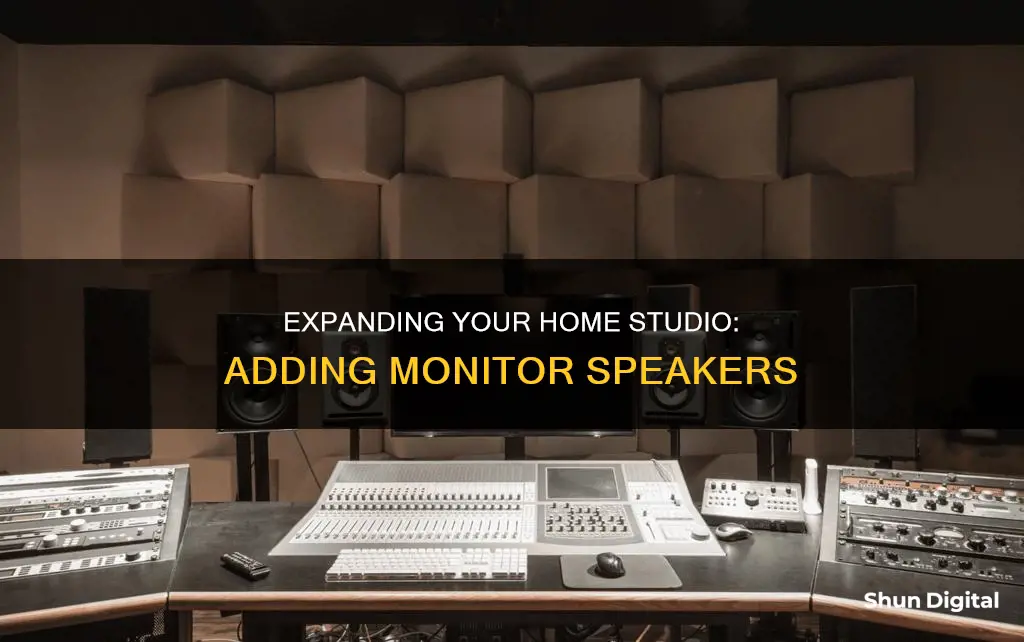
Adding more monitor speakers to your home studio can be a great way to improve your audio setup and enhance your listening experience. However, it's important to consider several factors to ensure optimal sound quality and performance. Firstly, decide on the type of monitor speakers you want to add. There are two main types: active monitors, which have built-in amplifiers, and passive monitors, which require external amplifiers. Active monitors are generally easier to set up and use, while passive monitors offer more flexibility. Another factor to consider is the size of the monitors. For a home studio, 5-inch speakers are often a good choice as they are suitable for most music styles and room sizes.
When adding more monitors, it's crucial to position them correctly. The ideal setup is to form an equilateral triangle, with the monitors at two corners and your listening position at the third. This ensures a clear stereo sweet spot. Additionally, make sure the monitors are at ear height and angled slightly towards your head to capture the high frequencies accurately. It's also recommended to place the monitors at least 10-60 cm away from the wall behind them to minimise sound reflections.
To connect multiple monitor speakers, you may need to purchase a monitor controller or a similar device, which allows you to easily switch between different audio sources and control the volume. This can be especially useful if you want to A/B test recordings on different sets of monitors without rewiring.
| Characteristics | Values |
|---|---|
| Speaker placement | Speakers should be placed to form an equilateral triangle with your head. |
| Speaker height | Speakers should be at ear level. |
| Speaker angle | Speakers should be angled towards your ears. |
| Speaker distance from walls | Speakers should be placed 10-60cm away from the wall behind them. |
| Speaker distance from side walls | Speakers should be equidistant from their respective side walls. |
| Speaker distance from each other | Speakers should be spaced 67.5 inches (171.5 cm) apart. |
| Speaker orientation | Speakers should be upright, not on their sides. |
| Speaker isolation | Speaker isolation pads can help to mitigate vibrations and resonances. |
| Speaker stands | Speaker stands can be used to position speakers correctly and ensure they are at the correct height. |
| Speaker cables | High-quality speaker cables should be used to minimise signal loss and interference. |
| Acoustic treatment | Acoustic panels and bass traps can be used to improve the accuracy of your monitors. |
| Room correction plugins | Room correction plugins can help to compensate for any anomalous frequency boosts or dips. |
| Monitoring levels | Monitoring levels should be reasonable and consistent. |
| Reference devices | Mixes should be checked on small devices such as tablets and smartphones. |
What You'll Learn

Speaker placement and geometry
The placement of your studio monitors is crucial in achieving an accurate frequency response and a solid stereo image. The ideal setup is to have your listening position and the two monitors form an equilateral triangle. This means that the distance between the left and right speakers and the distance from each speaker to the back of your head should be equal. You can use a tape measure, a piece of string, or even a guitar cable to set up this triangle. While there are recommended starting measurements for the triangle, the most important thing is that each side is the same length.
Studio monitors sound their best when listened to on-axis, so it is important to ensure the monitors point directly at your head, or slightly behind it. High frequencies are more directional than lower frequencies, so you may not hear the high frequencies accurately if the speakers are pointing too far off-axis. In general, we want the speakers to point directly towards our ears to minimise the high frequencies that bounce off the side walls.
Ideally, the tweeters should be at the same height as your ears when you are seated, typically about 47-55 inches (120-140 cm) from the floor. If you need to clear the top of your computer monitor, you can place the speakers slightly higher and tilt them down towards you. However, tilting speakers is precarious and care must be taken to avoid them toppling over.
Positioning your head inside the triangle ensures a natural stereo "sweet spot" that lets you move around a bit and even have a collaborator sit next to you. The nearfield speakers should be spaced 67.5 inches (171.5 cm) apart, but this is only a starting point. If your room forces you to sit closer to your front wall, you can move the monitors closer together to achieve something close to an equilateral triangle. If your speakers are physically large, a larger triangle will probably make sense, and vice versa.
Try to place your monitors either almost against the front wall or at least 43 inches (110 cm) away from it. If your speakers are placed close to the front wall, their bass response will be exaggerated by up to 6dB. Many monitors provide onboard EQ settings such as whole-space (flat EQ for placement away from any walls), half-space (slight bass reduction for placement near the front wall), and quarter-space (increased bass reduction for placement near front corners). Keeping symmetry in mind, the left and right speakers should be equidistant from their respective sidewalls.
If your speakers have a rear port, keep them away from the wall at least the same distance as the diameter of the port, usually about 5 to 10 centimeters. Speakers placed with their front surface more than 15 inches (38 cm) and less than 44 inches (110 cm) from the front wall run the risk of creating uneven bass response due to low-frequency reflections from the front wall. Similarly, try to place your speakers at least 44 inches from their nearest sidewall. If your speakers must be placed near a sidewall or a corner, try the quarter-space EQ setting on the speaker to mitigate any extra bass build-up.
Speaker placement should be either close to the front wall or more than 44 inches (110 cm) away from it. Locating the speaker in between will cause speaker-boundary interference (SBIR) that can lead to low-frequency cancellations.
It may be beneficial to decouple the speakers from their stands or the desk surface they are resting on to prevent the desk or stands from vibrating and absorbing or amplifying certain frequencies. Speaker isolation pads help mitigate vibrations and resonances by absorbing them before they can transfer to the furniture.
Careful monitor placement and isolation will ensure that what you hear is the most accurate sound your speaker system can produce.
Connecting a Famicom Clone: Monitor Setup Guide
You may want to see also

Monitor size and room size
When adding more monitor speakers to your home studio, it's important to consider the room size and shape to achieve optimal sound quality. Here are some detailed guidelines on monitor placement in relation to room size:
The placement of your monitors in the room is crucial for achieving accurate sound reproduction and minimizing acoustic issues. The size and shape of the room will determine the ideal placement of your monitors and listening position. Here are some key considerations:
- Room Dimensions: The dimensions of the room will affect sound reflections and standing waves. In a rectangular room, it is recommended to divide the room into three equal sections and place your setup in the front area. This helps minimize potential reflections from the side walls.
- Monitor Triangle: An important principle to follow is the equilateral triangle setup. Position your monitors and listening seat to form an equilateral triangle, with the monitors angled towards your head. This ensures a balanced stereo image and consistent listening perspective.
- Monitor Height: Adjust the height of your monitors so that the tweeters or high-frequency drivers are at ear level when seated. This ensures you receive more direct sound, resulting in a clearer and more detailed listening experience.
- Distance from Walls: Monitors should be placed at a distance from walls and corners to reduce sound reflections. A minimum distance of 20-30 cm (8-12 inches) is recommended, with a maximum distance of 60-90 cm. The distances between the monitors and the side and back walls should be different to avoid creating corners in the listening position.
- Bass Build-up: The closer your monitors are to the rear wall, the stronger the low-end bass build-up will be. Moving the monitors further from the wall increases the frequency, making it easier to treat the resonance.
- Side Walls: Maximizing the distance from side walls is generally beneficial. Ensure that the distance from each side wall to the listening position is similar, creating symmetry and a consistent acoustic reflection quality.
- Room Treatment: Consider using acoustic treatment products such as panels, bass traps, and diffusers to improve sound absorption and reduce reflections. This is especially important for treating rear and side walls, as well as the ceiling, to minimize standing waves and create a more controlled listening environment.
- Monitor Stands: Consider using monitor stands to achieve the optimal monitor height and angle. Desktop stands provide a compact solution, while floor stands are suitable for larger studios and bigger monitors.
- Speaker Cables: Use balanced 1/4-inch speaker cables in TRS format to reduce unwanted noise and maintain signal integrity.
- Room Correction Plugins: If your room has a challenging layout, such as a small square room or an L-shaped space, consider investing in room correction plugins like IK Multimedia's ARC 3 or Sonarworks Reference Speaker.
- Monitor Placement Tools: Utilize tools like room mode calculator software and Room EQ Wizard to identify problematic frequencies and optimize monitor placement accordingly.
- SPL Meter: Monitoring at high volumes for extended periods can damage your hearing. Use an SPL meter app to ensure you stay within safe volume levels, with the recommended workplace level being 85 dB SPL or below.
Adjusting Monitor DPI on Your MacBook Pro
You may want to see also

Active vs passive monitors
When it comes to studio monitors, you have two options: active or passive. So, what's the difference, and which one is right for you?
Active Monitors
Active monitors have built-in amplifiers, which means they are simple to set up and don't require any additional equipment. They are often a plug-and-play solution, reliable, and accurate. The built-in amplifiers are designed specifically for the monitors, which can result in better overall sound quality. Active monitors are also convenient and perform well, which is why many professional studios use them.
Passive Monitors
Passive monitors, on the other hand, require external amplifiers to work. They offer more flexibility as you can choose an external amplifier that perfectly matches your monitors. Passive monitors are also great if you want a gradual and less expensive upgrade path, as you can upgrade the speakers and amplifier separately. Additionally, you might prefer passive monitors if you already have a specific reason to prefer a passive system.
Factors to Consider
When deciding between active and passive monitors, consider your needs, preferences, and the space in which they will be used. If you want a simple, reliable, and accurate solution, active monitors are a good choice. If you're willing to put in some extra effort and want more flexibility, passive monitors might be better. Another thing to keep in mind is the cost. Active monitors typically have a higher wattage rating and offer better frequency response and sound reproduction, which can make them more expensive. However, a higher price tag doesn't always guarantee higher quality, so it's important to compare products within a similar price range.
Setting Up KRK Subwoofers with Studio Monitors: A Guide
You may want to see also

Amplifier configurations
The single-amp configuration is the simplest setup, commonly found in computer speakers. In this configuration, both the left and right speakers are powered by a single integrated amplifier. While this setup is straightforward, it offers limited control over the frequency response.
The bi-amp configuration, on the other hand, provides greater control and precision. Each speaker in a bi-amp setup contains two amplifier modules, allowing for dedicated amplification of each driver. This configuration is often used in professional studios, where accuracy and attention to detail are of utmost importance. While some 3-way speakers use two amplifier channels, with one powering the woofer and the other powering the midrange speaker and tweeter through a passive filter, this is not the ideal way to amplify 3-way systems.
The tri-amp configuration is the most advanced and complex option. In this setup, each driver in a 3-way speaker (woofer, midrange, and tweeter) has its own dedicated amplifier, providing ultimate control over the frequency response. Tri-amp configurations are typically found in high-end professional studios, where the highest level of accuracy is required.
When choosing an amplifier configuration, consider the level of precision and control needed for your studio setup. For most home studios, a single-amp or bi-amp configuration should suffice, with the latter providing more accurate sound reproduction. If you require the highest level of detail and flexibility, the tri-amp configuration is the optimal choice.
Additionally, it is worth noting that active studio monitors with built-in amplifiers are generally more convenient and straightforward to set up, while passive monitors offer more flexibility by allowing you to choose external amplifiers that best suit your needs.
Best Places to Buy HP Monitors
You may want to see also

Wattage
For a beginner or someone working in a small-to-medium-sized room, a studio monitor with 50-75 watts per channel is a good starting point. However, if you're in a large commercial studio, you may need to consider a monitor with a higher wattage, such as 100 watts or more per channel.
It's worth noting that just because a studio monitor has a high wattage, it doesn't mean it's the best option. Quality is key, and a well-designed, high-quality studio monitor with a lower wattage rating can often sound better than a cheaper one with a higher wattage.
The best way to determine the right wattage for your needs is to test the monitors in your room and listen to your material. If they can produce the sound pressure level you need without any distortion, then they are suitable. If you require more volume, then consider a higher wattage rating.
Additionally, when it comes to amplifier configurations, the bi-amp configuration is worth considering. In this setup, each driver in a 2-way speaker has its own dedicated amplifier, allowing for greater control over the frequency response and more precise sound reproduction. This is often used in professional studios where accuracy and detail are crucial.
In summary, wattage plays a significant role in ensuring your studio monitors can deliver the desired sound levels without distortion. The specific wattage you need depends on the size of your studio and your personal requirements. Testing and comparing different options will help you make an informed decision.
Monitoring Electrical Usage: Individual Breakers and Their Secrets
You may want to see also
Frequently asked questions
You can use a monitor controller to easily switch between different audio sources and control the volume.
The ideal setup is to have your listening position and the two monitor speakers form an equilateral triangle. The speakers should be placed on stands or a mixing console, with the listener seated a few feet away, and the speakers positioned at the height of the listener's ears.
The performance of your monitor speakers will be impacted by the physical properties of the room. To reduce standing waves, make sure the speakers are at least 10-60cm away from the wall behind them. You can also use acoustic panels and bass traps to dampen down reflections, or add soft and irregular surfaces such as sofas, heavy curtains, and bookshelves to deaden the room.







